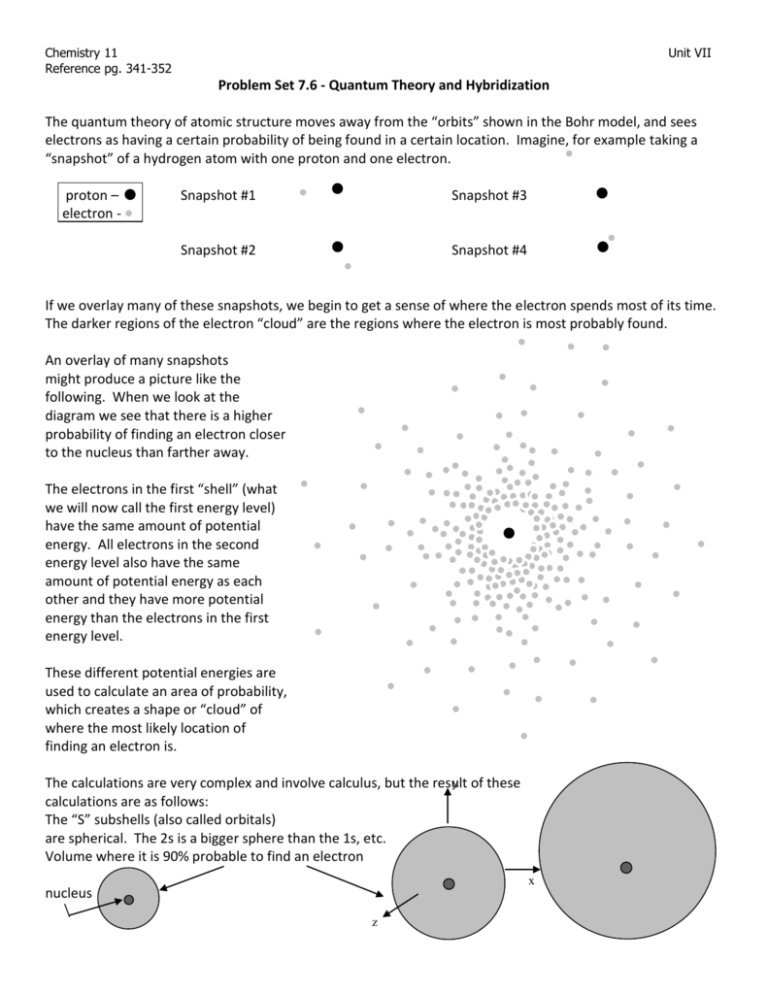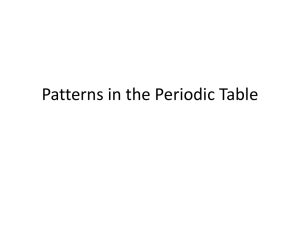Hybridization - Chemistry 11
advertisement

Chemistry 11 Reference pg. 341-352 Unit VII Problem Set 7.6 - Quantum Theory and Hybridization The quantum theory of atomic structure moves away from the “orbits” shown in the Bohr model, and sees electrons as having a certain probability of being found in a certain location. Imagine, for example taking a “snapshot” of a hydrogen atom with one proton and one electron. proton – electron - Snapshot #1 Snapshot #3 Snapshot #2 Snapshot #4 If we overlay many of these snapshots, we begin to get a sense of where the electron spends most of its time. The darker regions of the electron “cloud” are the regions where the electron is most probably found. An overlay of many snapshots might produce a picture like the following. When we look at the diagram we see that there is a higher probability of finding an electron closer to the nucleus than farther away. The electrons in the first “shell” (what we will now call the first energy level) have the same amount of potential energy. All electrons in the second energy level also have the same amount of potential energy as each other and they have more potential energy than the electrons in the first energy level. These different potential energies are used to calculate an area of probability, which creates a shape or “cloud” of where the most likely location of finding an electron is. y of these The calculations are very complex and involve calculus, but the result calculations are as follows: The “S” subshells (also called orbitals) are spherical. The 2s is a bigger sphere than the 1s, etc. Volume where it is 90% probable to find an electron x nucleus z Chemistry 11 Reference pg. 341-352 Unit VII The 1s orbital The 2s orbital The 3s orbital The p orbitals have a very different shape, they look more like lobes, with a node in the middle (nucleus). The 2p orbital The 3p orbital Each orbital can hold 2 electrons. Since the p subshell can hold 6 electrons in total, there are 3 p orbitals to hold the 6 electrons. One orbital yis oriented in the x direction, one in the y and one in the z. The nucleus is at the origin. x z A view of many overlapping snapshots of a p orbital The “d” orbital shapes are more complex yet and can be seen in a first year chemistry text. The question is how do these orbitals lead to bonding? For example, a bond may form from some s and some p electrons, but since the p electrons are in orbitals at 90 degrees to each other how does this work for bonds that are at 109 degrees? The answer to the question lies in the mashing together of these s and p orbitals in order to come up with new orbitals. These new orbitals are called hybrid orbitals. For each s or p put into the mix, one hybrid must be made. Consider CH4. H The Lewis diagram looks like: H H C H If we look closely at the outside shell of C we see that there are two 2s electrons and two 2p electrons. The s electrons are in a spherical arrangement and the p electrons are in lobes as pictured above. This does not connect to the 109.5 o we expect for the bonds that form. Since these 2s and 2p electrons are the ones used in bonding, we must resolve this issue. Chemistry 11 Reference pg. 341-352 Unit VII In order to explain it, we take these 4 orbitals (one 2s orbital and three 2p orbitals – the 2px the 2py and the 2pz) and make 4 hybrid orbitals that will be called all be called sp3. The name comes from the fact that the new orbitals are a mixing of one ‘s’ orbital and three ‘p’ orbitals. In short, whenever a molecule has a tetrahedral shape with 4 bonds, it must be sp3 hybridized. The 4 bonds mean there must have been four orbitals put in the mix (the s and the 3 p’s) If a molecule is trigonal planar (three bonds) it must have come from one s orbital and two p orbitals and, so it is sp2 hybridized. If a molecule is linear (two bonds) it must have come from an s orbital and a p orbital and is sp hybridized. The following chart summarizes all hybridizations. Chemistry 11 Reference pg. 341-352 Unit VII Summary of bond angles, shape names and hybridization items repelling bonds lone pairs bond angle ( o ) name Hybridization of central atom example 2 2 0 180 linear sp H-C=C-H 3 0 trigonal planer BF3 3 120 sp2 2 1 bent N=O H 4 0 109.5 tetrahedral 3 1 107 (109.5 ok) trigonal pyramid 2 2 104 (109 ok) bent CH4 sp3 NH3 4 Complete pg. 348 #1-2 7.53 Going back to problem 7.46 in the VESPRT problem set, list the hybridization for those structures which have a central atom. H2O






